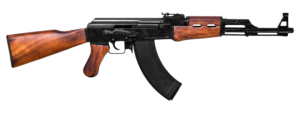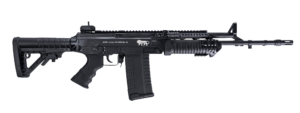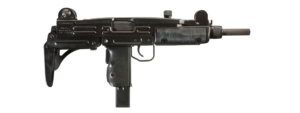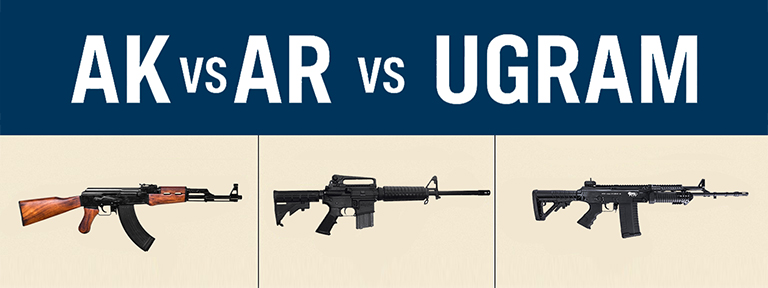Assault Rifle Vs Battle Rifle Vs Carbine: Best type of rifle for Indian Defence
When discussing the types of rifles used by armed forces globally and specifically by the Indian Defence forces, it’s essential to understand the differences and roles of assault rifles, battle rifles, and carbines. Each rifle category is crafted with distinct strengths suitable for specific combat scenarios. Here’s a simplified explanation to help understand the nuances and suitability of each type for India’s Defence needs, particularly highlighting battle rifles like dvipa’s Battle Rifle U-51 (UGRAM).
What is an Assault Rifle?
An assault rifle is a versatile firearm designed primarily for infantry use. It typically fires an intermediate cartridge, offering a balance of power and control—more potent than pistol rounds but lighter than full-powered rifle cartridges. Assault rifles generally feature selective fire modes: semi-automatic, automatic, or burst-fire settings.

The AK-47 and the Indian-developed INSAS rifles, widely employed by Indian Defence forces, are prime examples. Assault rifles excel in short-to-medium-range engagements (300-500 meters), providing adaptability in close combat and urban warfare scenarios.
What is a Battle Rifle?
Battle rifles differ primarily in ammunition and intended purpose from assault rifles. They fire full-powered rifle cartridges, like the robust 7.62×51mm NATO round. This larger ammunition provides significantly greater range, accuracy, and superior stopping power—a critical advantage—albeit at the expense of increased recoil, weight, and reduced ammunition-carrying capacity.

Battle rifles such as the FN FAL, SIG 716, and particularly dvipa’s Battle Rifle U-51 (UGRAM) represent modern advancements in firearm technology. They are especially effective at medium-to-long-range engagements (600-800 meters and beyond), ideal for open terrain or mountainous border regions, where the need for reliable long-range accuracy is paramount.
What is a Carbine?
Carbines are shortened, lighter versions of standard rifles, often derivatives of assault rifles. They retain the intermediate ammunition but feature shorter barrels and lighter construction, increasing maneuverability in tight environments. Carbines are ideal for specialized forces, vehicle-mounted infantry, and soldiers operating in urban or densely forested terrains.

The globally reacognized M4 Carbine and the CAR 816, adopted by Indian Defence forces, exemplify this rifle category, effective within 200-400 meters.
Comparative Analysis: Suitability for Indian Defence
Assault Rifle: The Versatile Choice
Assault rifles balance firepower, range, and maneuverability, crucial for India’s diverse terrain—jungles, urban environments, semi-arid plains, and mountainous regions. The Indo-Russian AK-203, set for indigenous production in India, addresses such multifaceted requirements effectively.
Battle Rifle: Strength at a Distance and Superior Stopping Power
Battle rifles are indispensable in scenarios demanding higher accuracy and superior stopping power at extended ranges. The term “stopping power” describes a bullet’s ability to immediately incapacitate a target, eliminating their fighting capability—a critical tactical advantage during border confrontations.
Recognizing this decisive advantage, the Indian Army has shifted its doctrine from “shoot to injure” to “shoot to kill” and is replacing INSAS rifles with battle rifles, particularly in sensitive border areas. In operational environments such as the Line of Control (LOC) with Pakistan and the Line of Actual Control (LAC) with China, rifles like the dvipa U-51 (UGRAM), specifically designed for the Indian Defence Forces, empower soldiers to engage adversaries effectively at extended ranges, ensuring greater operational superiority and control.
The dvipa Battle Rifle U-51 (UGRAM), utilizing the powerful 7.62×51mm cartridge, fulfills the crucial demand for enhanced long-range capability and stopping power, representing India’s homegrown innovation and defence manufacturing strength.
Carbine: Mobility and Quick Response
Carbines stand out in fast-paced, specialized missions—counter-insurgency, anti-terror operations, urban combat, and close-quarters battle. India’s Defence forces regularly engage in operations within urban landscapes and difficult terrains. Carbines, such as CAR 816, ensure rapid response, maneuverability, and efficient handling.

Conclusion: Battle Rifle U-51 (UGRAM) and India’s Defence Strategy
For India’s diverse Defence requirements, no single rifle type alone offers a complete solution. A diversified approach combining assault rifles, battle rifles, and carbines is crucial. Assault rifles form the infantry backbone, carbines offer specialized mobility, and most significantly, battle rifles equip forces with the necessary superior stopping power and extended-range capability critical at India’s challenging borders.
The introduction of dvipa’s battle rifle U-51 (UGRAM) is a significant step forward, underscoring India’s indigenous defence capabilities. The rifle is meticulously designed for India’s unique security scenarios, enhancing soldiers’ effectiveness, safety, and confidence in the field.
By integrating each rifle type effectively—including the powerful and accurate U-51 (UGRAM) battle rifle by dvipa—India ensures comprehensive operational readiness, enhanced combat effectiveness, and strategic advantage across all tactical environments.

